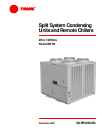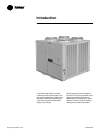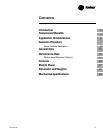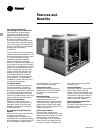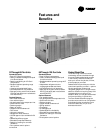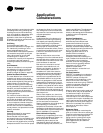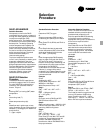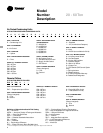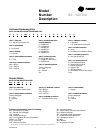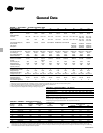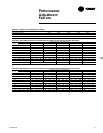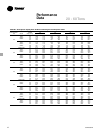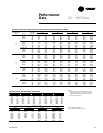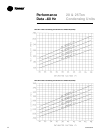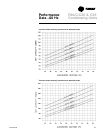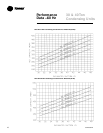
SS-PRC005-EN6
Application
Considerations
capacity and efficiency. The adjustment
factors in Table PAF-1 can be applied
directly to the catalog performance data
to determine the unit’s adjusted
performance.
Ambient Considerations
Start-up and operation at lower
ambients requires sufficient head
pressure be maintained for proper
expansion valve operation. At higher
ambients, excessive head pressure may
result. Standard operating conditions are
40°F to 115°F. With a low ambient
damper, operation down to 0°F is
possible. Minimum ambient
temperatures are based on still
conditions (winds not exceeding five
mph). Greater wind velocities will result
in increased minimum operating
ambients. Units with hot gas bypass
have a minimum operating ambient
temperature of 10°F. For proper
operation outside these
recommendations, contact the local
Trane sales office.
Coil Frost Protection
FROSTAT™ is standard on condensing
units when the VAV option is ordered.
FROSTAT consists of a ship-with
thermostat for field installation on the
suction line. A timer is also factory-
installed to avoid short cycling. FROSTAT
cycles the compressor off when the
suction line is below 30°F. Refer to
S/S-EB-43 for more detail.
When hot gas valves must be used on 20
to 120-ton units, they can be ordered as
a miscellaneous option. 20 to 30-ton
units require one valve; 40 to 60-ton
units also require one valve except when
no system control option is selected; this
option requires two valves. 80 to 120-ton
units require one valve when Supply Air
VAV control is selected. Two valves are
required on all other 80 to 120-ton
control options.
Refrigerant Piping
Special consideration must always be
given to oil return. Minimum suction gas
velocities must always be maintained for
proper oil return. Utilize appropriate
piping tools for line sizing such as the
CDS Refrigerant Piping Program. For
special applications, call Clarksville
Product Support.
envelopes also allow for control panel
door swing and rountine maintenance
requirements. Local code requirements
may take precedence.
Unit Location
Unobstructed flow of condenser air is
essential for maintaining condensing
unit capacity and operating efficiency.
When determining unit placement,
careful consideration must be given to
assure proper air flow across the
condenser heat transfer surface. Failure
to heed these considerations will result
in warm air recirculatioin and coil air
flow starvation.
Warm air recirculation occurs when
discharge air from the condenser fans is
recycled back at the condenser coil inlet.
Coil starvation occurs when free air flow
to the condenser is restricted.
Both warm air recirculation and coil
starvation cause reductions in unit
efficiency and capacity. In addition, in
more severe cases, nuisance unit
shutdowns will result from exessive
head pressures. Accurate estimates of
the degree of efficiency and capacity
reduction are not possible due to the
unpredictable effect of varying winds.
When hot gas bypass is used, reduced
head pressure increases the minimum
ambient condition for proper operation.
In addition, wind tends to further reduce
head pressure. Therefore, it is advisable
to protect the air-cooled condensing unit
from continuous direct winds exceeding
10 miles per hour.
Debris, trash, supplies, etc., should not
be allowed to accumulate in the vicinity
of the air-cooled condensing unit. Supply
air movement may draw debris between
coil fins and cause coil starvation.
Special consideration should be given to
units operating in low ambient
temperatures. Condenser coils and fan
discharge must be kept free of snow and
other obstructions to permit adequate air
flow for satisfactory unit operation.
Effect of Altitude on Capacity
Condensing unit capacities given in the
performance data tables on pages 11 to
24 are at sea level. At elevations
substantially above sea level, the
decreased air density will decrease
condenser capacity and, therefore, unit
Certain application constraints should be
considered when sizing, selecting and
installing Trane air-cooled condensing
units. Unit reliability is dependent upon
these considerations. Where your
application varies from the guidelines
presented, it should be reviewed with the
local Trane sales engineer.
Unit Sizing
Unit capacities are listed in the
performance data section on pages 11 to
24. Intentionally oversizing a unit to
assure adequate capacity is not
recommended. Erratic system operation
and excessive compressor cycling are
often a direct result of an oversized
condensing unit. In addition, an
oversized unit is usually more expensive
to purchase, install and operate. If
oversizing is desired, consider using two
units.
Unit Placement
A base or foundation is not required if
the selected unit location is level and
strong enough to support the unit’s
operating weight (as listed on page 45).
Isolation and Sound Emission
The most effective form of isolation is to
locate the unit away from any sound
sensitive area. Structurally transmitted
sound can be reduced by using spring or
rubber isolators. The isolators are
effective in reducing the low frequency
sound generated by compressors and,
therefore, are recommended for sound
sensitive installations. An acoustical
engineer should always be consulted on
critical applications.
For maximum isolation effect, the
refrigeration lines and electrical conduit
should also be isolated. Use flexible
electrical conduit. State and local codes
on sound emissions should always be
considered. Since the environment in
which a sound source is located affects
sound pressure, unit placement must be
carefully evaluated.
Servicing
Adequate clearance for compressor
servicing should be provided.
Recommended minimum space
envelopes for servicing are located in the
dimensional data section of this catalog
and can serve as guidelines for providing
adequate clearance. The minimum space



